Following World War II, Yugoslavia’s new communist government under Marshal Josip Broz Tito began to distance itself from Soviet-style communism in 1948, and started to build its own way to socialism as an independent communist state. TheYugoslavian government was seeking to establish and develop new industries and requested financial aid from America, which was initially agreed to start on a small scale in 1949, then with further investment increasing in 1950-53.
Discussions with the Austrian Steyr–Daimler–Puch company in July 1954 resulted in a licence contract to produce and supply branded Puch moped models into the Eastern European market. The tough and economical small capacity Puch geared models were particularly suited for use on the gravel roads and steep terrain that characterised the region, and Puch further offered the incentive of some very favourable licensing terms, as they rather doubted the business would actually become established or ever be capable of operating independently.
In August 1954 the name Tomos appeared in company documents for the very first time, its name being an acronym made from the words TOvarna MOtornih koles Sežana (Slovenian for Motor cycle Company Sežana) and, in October 1954, the Slovenian regional government began construction of the new Tomos factory outside Koper, a coastal industrial township.
Production from temporary facilities started in 1955 when Tomos assembled 137 Puch SG 250cc split-single motor cycles along with 124 Puch RL 125cc scooters and 100 mopeds under the Tomos brand.
The finally completed main factory was officially opened in 1959 by Josip Broz Tito, President of Yugoslavia, and Tomos machines became produced in increasing volumes for export sales to raise national revenue.
Tomos machines were first imported to the Netherlands by NV Vedezo in 1960, with the moped models resembling the Puch in appearance, but being priced a little more cheaply.
The 1960s were to prove a most productive period for the new Slovenian company, with strong sales in the Netherlands quickly establishing this as a very important market within the very first year.
In 1962 a new model was released with a 90cc engine.
Tomos mopeds sold so well in the Netherlands that a Dutch factory was constructed at Epe in 1966 to begin assembling complete machines imported as parts from Sežana for distribution by Tomos Nederland; this was Tomos’s only plant outside of Slovenia.
Tomos NL graduated to building its own models specifically for the Dutch market, with an Anker–Laura M48 powered automatic in 1968, then another M48 model with smaller 16-inch wheels in 1969, and assembling the first Tomos A3 single-speed auto models in 1973.

‘Tjerk’ Westerterp [CC0] Nationaal Archief
Mopeds (Bromfiets) in the Netherlands were included under specific vehicle regulations and mopeds at this time in the Netherlands were not registered as such; they were only marked by rear plates for insurance. A Dutch moped has a maximum construction speed of 45–50km/h (27–30km/h), and is identified by a yellow plate on the front mudguard; in 1975 it became mandatory to wear a helmet on these mopeds.
There were objections to the helmet law, particularly in rural areas where women still wore the traditional Dutch headdress, so a new Snorfiets category of moped (identified by an orange plate on the front mudguard), was introduced. This was a performance-limited class of moped restricted to 25–30km/h (16–18km/h), for which wearing a crash helmet was only optional, and not a mandatory requirement. The term ‘Snorfiets’ is a euphemism meaning ‘purring bicycle’, though machines are sometimes further referred to as ‘Mustache’ in Holland, since ‘Snor’ also translates to moustache in English.
‘Westerterp Wieltjes’
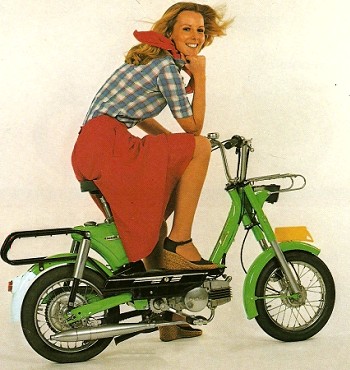
Sparta Funny

Sparta Happy
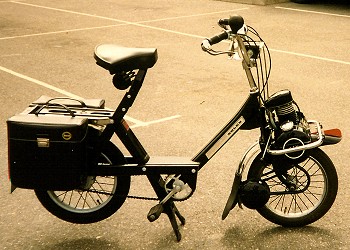
Solex 5000
The maximum speed that a Mustache or Snorfiets moped may reach is 5km/h above the construction speed. Therefore, a bromfiets may run up to a maximum of 50km/h, and a snorfiets to 30km/h, but the rider would be obliged to keep to the specified maximum speeds of 45 and 25km/h respectively.
Snorfiets was a category commonly described by Dutchmen as ‘low-power motorised two-wheelers with which your grandmother could do the shopping’, and restricted to comply with this specification, typically by fitment of a diminutive 8mm carburettor or other limiting means. These Dutch moped specification changes were made under the jurisdiction of Theodorus Engelbertus Westerterp, who was Minister van Verkeer en Waterstaat from the 11th May 1973 till 19th December 1977. Before the changes, Dutch mopeds were not allowed to have small wheels, but the new snorfiets category used smaller wheels with 12-inch rims (16-inch tyres); spawning a new generation of ‘Westerterp wheel’ mini-bikes in the Netherlands, such as the Batavus City, Batavus M-20, Solex 5000, Sparta Funny, Sparta Happy, and Tomos S1.
According to the subject of our article, our particular interest is obviously the last one on this list, but just to make this difficult, there isn’t much definitive information to be found on the S1—why is life never easy?
Production of the S1 started in 1976, and was a model uniquely designed and built at Tomos Nederland Epe to snorfiets specification, specifically for the Dutch home market.
It initially employed the silver finish, single-speed automatic Tomos A3 pedal moped engine, fitted into the purpose-built mini-bike frame (later two-speed automatic A3N engines were finished in black). Because changes to the internal motor gearing were not practical, and increase of the final drive sprocket was very limited by space, the bike was simply installed with a standard motor … however the small 12-inch diameter wheels with 16-inch diameter tyres had reduced the final drive ratio by 20% compared to the original Tomos moped size of 16-inch diameter wheels with 20-inch diameter tyres. Since the standard Tomos hubs were also employed, there wasn’t much option to further reduce the size of the rear sprocket to compensate such a drive ratio reduction, so the bike was produced dramatically under-geared. To prevent the motor being over-revved and to limit the performance down further to meet snorfiets specification, the standard 12mm carburettor was replaced by an 8mm Encarwi, which reduced the power rating to around 0.9–1bhp, complying with the snorfiets 25km/h performance limit.
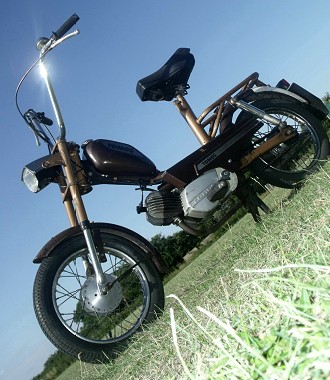
1.2 × 12 Silverseal Westrick pattern 36-hole wheel rims were spoked onto standard Tomos hubs, and fitted with 2.25×12 (16×2.25) tyres produced specially for the model by the Dutch Vredestien tyre company. This bike is believed to be an early example, with an original two-tone metallic brown colour scheme and spoked wheels, while later examples changed to cast alloy wheels, still in the same size.
The factory colour codes are reportedly given as: green 013, blue 016, and brown 019.
Some components are readily recognisable as standard or derived Tomos moped fittings like the saddle, exhaust, and side panels, while other parts are European proprietary fittings like the Niox (Austrian) headlamp, Luxor type-75 rear lamp, Magura controls, and IKJ switchgear. We’re unsure about the source of the fuel tank, but it fits a continental pattern fuel cap and has a M10 × 1mm right-hand thread tap, which may suggest Italian manufacture?
When this particular example was brought to the UK, its snorfiets limited specification for use on Dutch cycle tracks was not something that we had as such in Britain, where all types of motorised vehicles are primarily intended for road use. The snorfiets proved to be woefully short of the performance required for any real practical purpose, and to try to ‘encourage’ it a little, the motor was refitted with a 12mm carburetter, which will probably have returned the power output towards the 2bhp of a standard motor.
We don’t know what the original sprockets and gearing were in the specification, but we’re under the belief that one or both might have been changed. The currently fitted rear sprocket is 22-tooth, and the smallest that could be fitted on the hub would be 20-tooth. while the front sprocket is 26-tooth, with 27-, 28-, and 31-tooth being available, though the last could well require some ‘relief’ of the engine casing to fit.
The fuel tap (off–on–reserve) is tucked away at the bottom right of the fuel tank, just in front of the side panel. The Encarwi carburettor choking function on the Tomos is rather unusual, push the black thumb button on the throttle away from your hand, and turn the throttle forward to ‘extended’ range. The choke function will automatically disengage when you open the throttle again, and the twistgrip returns to normal range as the thumb button re-engages the choke latch.
How you get the engine started isn’t immediately clear, because rotating the pedals forward only cycles the machine like a bicycle, and pedalling up to any speed still fails to turn the motor. There’s no clutch-lock lever on the handlebars to engage the drive … but when you go to back-pedal, then the engine turns over. Just a single back-kick gets the motor to start right away, with a fierce bark and loads of angry revs, but it’s best to not to try opening the throttle too soon, or the choke action cuts right off, and the engine could stop immediately, then you’re back to step one of resetting the black thumb button and throttle.
Just leave it to run a little while, then twist back the throttle to clear the choke, and the engine reverts to a strong pulsing tick-over.
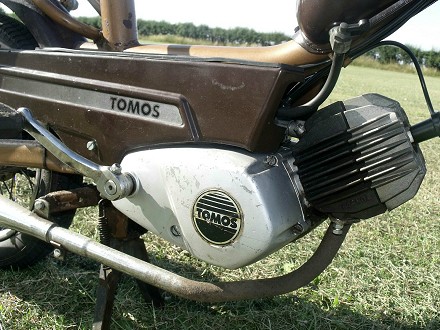
Nudge off the stand, step through the open frame to nest on the seat. The S1 is a really small bike, only 55 inches long, with just a 39-inch wheelbase, so your knees are already under the high-rise handlebars. This isn’t cosy, it’s crowded, and you immediately wonder how a tall Dutchman might have managed? The answer is simple: he bought something else!
It’s a little bike, so what does it weigh? 2st 13lb front, and 3st 8lb rear, so a total of 6½st (41kg).
The exhaust note on tick-over sounds proud and confident with a crisp pulse from the silencer, then open the throttle and the revs increase to a strong burble as the automatic clutch feeds in the drive. S1 accelerates away very capably, and feels nice and strong, but we’ve only gone up the road a very short distance and there’s a rapid realisation that the gearing ratio is very much lower than the power output on this example.
Having power and available revs is fine, but with such a low drive ratio as this, you’re going to have to exercise restraint, otherwise it could be very easy to damage the engine.
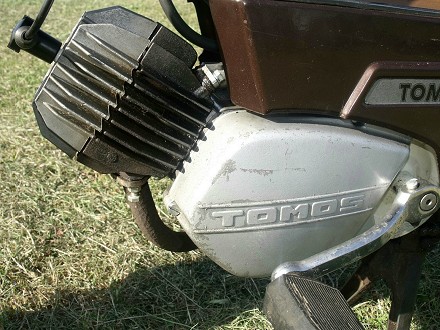
We initially tested our S1 on the EACC CARD Run, on the basis that its snorfiets category performance wouldn’t be outpaced by the cyclemotor and roller-drive machines at this event. While the Tomos performed very well on acceleration and particularly on hill-climbing ability, by the time it was pacing with Cyclemasters, a Power Pak, and a Solex 6000 Flash in some 20km/h+ sections, the vibrations were becoming uncomfortable, and you probably wouldn’t want to be holding such revs for long.
The S1 was in its class among cyclemotors, but would clearly be well out of the running against most mopeds.
While the Tomos would certainly match and outperform the cyclemotors over a short sprint, you’d still put your money on the tortoise instead of the hare over a longer distance.
Tomos hub brakes usually work pretty well anyway, and with the smaller wheels were really very good.
Handling at low speed was quite clumsy, as the bike tended to sway around as you wavered with a clashing of knees and handlebars from the crowded riding position and uncomfortable posture created by the stubby frame. You could settle down better as the pace picked up, but the naturally assumed posture was never going to be much good for any length of time on the saddle.
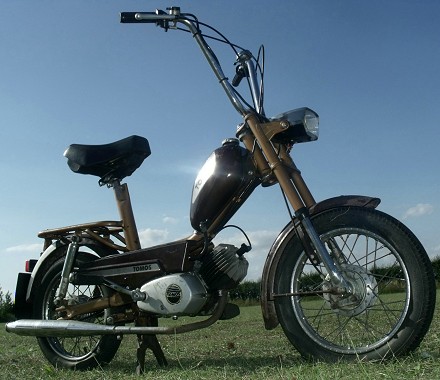
Tick-over was generally consistent, and the motor and the exhaust note sounded good. To stop the motor, press the cut-out button on the handlebar switch. Press the horn button, and nothing happens, because S1 isn’t fitted with a horn, Cyclemotor and Roller Driv were fitted with a bicycle bell … ding-a-ling!
With no speedometer fitted to the Tomos (and who’s really going to need a speedo on a bike built to a 25km/h specification?), what we still lacked was actual measured speeds, so back to mission control for a proper Sat-nav paced test.
Keeping in mind that this S1 has been tweaked up a little, and is expected to perform above and beyond its original specification, a comfortable and safe cruising speed settles down around 20km/h.
On flat in still air was briefly paced at 30km/h, and the revs the motor was running at this speed were becoming concerning, so it was just a quick burst up to this speed and immediately ease back, because the motor felt to be over-revving, and if held at that speed for any time would certainly result in problems.
There was no need to try and adopt a crouch position to try and reduce drag, because the low gearing was getting the motor up to revs no one would ordinarily run the bike at anyway.
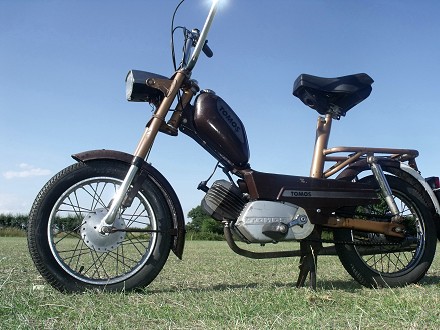
On the way back to base and approaching a light downhill section, there suddenly seemed to be a little devil whispering in our ear … ‘It’ll go faster than that, you know it can, it’ll rev more than that! Go on, just a brief burst’ … so downhill momentarily our pacer clocked S1 at 36km/h on a Sat-nav! You’d never believe how much a Tomos motor can rev, but only briefly, because within just few seconds you could feel the motor starting to tighten toward a piston seizure. Cast iron cylinders on two-strokes often have problems conducting the heat away fast enough at sustained high revs. You can’t shut the throttle down because that will cut off the cooling air and lubrication that’s going through the motor, and it’d seize instantly. Keep the throttle wide open and pull on the brakes to drag the speed and revs down, and only then ease back the throttle as the revs have dropped, and that reaction saves the engine.
Within just a few hundred yards, the risk has passed, so snap round the twistgrip in a series of full open throttle bursts to draw fresh blasts of cooling air/fuel mix into the motor, and all is well, so we cruise back to base at 20km/h and the Tomos sits on the drive, steadily ticking over as if nothing has happened.
Surprise and respect for any motor that can rev like that!
The rear carrier is part of the frame tubing, and has an inbuilt spring-loaded luggage clip, but on this mini-bike it’s low and out of reach unless you bend down to it, so you naturally handle the S1 from the back of the saddle. The first time you do this, you’re surprised to find there’s a plastic toolbox lid that clips into the back of the saddle, which unexpectedly unclips, and scatters its contents all over the floor—well that was an interesting discovery.
The 6V AC lights seem very bright for such a little bike, but that’s probably because the high revving engine is charging lots of output from the generator. Bright lights are OK, but we do wonder if they might fuse-out at high revs?
The frame number is stamped 363081 on the right-hand side engine mounting plate, but would be unseen unless you removed the right-hand side panel. Unsurprisingly, the Epe NL frame number series doesn’t equate to the Slovenian sequence, so gives us no helpful reference. Also engraved on the frame on the top right-hand side of the saddle stem is 2901AS13, which appears to be a valid Dutch postcode with the number of the owner’s house in Capelle aan den IJssel. Still no help.
S1, and seemingly SF1 coded models also have been produced, but we’re not entirely sure what the difference might be? You’d think it might have signified the change to alloy wheels, or fitment of the later A3N two-speed automatic engine, but SF1’s seem to become referenced from 1977, apparently still fitted with the A3 single-speed automatic engine and spoked wheels.
A problem with these Dutch-market snorfiets mopeds is that they weren’t required to be registered, so there’s no fixed points of reference to go from, and forty or so years later, the factory that made them has gone, and nobody seems to have recorded anything about them!
The Tomos NL Epe factory operated its own research and development to assemble and produce new units for the Dutch market until 2009, when the longest surviving moped factory in the Netherlands ended operations due to production and labour costs being lower in Slovenia.
On 4th January 2019 the Slovenia Times printed a brief report under the heading:
—– Motorcycle maker Tomos sent into receivership ——
Koper - The Koper District Court sent famed motor cycle maker Tomos into receivership on Thursday (3rd January) after the Koper-based company failed to find a strategic partner to help it cope with liquidity issues.
The proposal for receivership was filed last November by Tomos employees after the company failed to pay their wages, contributions and the annual holiday allowance.
Since Tomos had neither contested being insolvent nor asked for a deferral, it is considered insolvent under the insolvency law.
‘The court decided to send the debtor into receivership,’ says the court’s decision, posted on the website of the Agency for Public Legal Records (AJPES).
The court appointed Štefan Veren the official receiver, giving creditors until 3 April to report their claims and secured debt.
When the workers filed for receivership, Tomos director and owner Iztok Pikl said the company could still be saved. However, he admitted it owed its employees two monthly salaries and the holiday allowance.
Pikl or his company MPO Kabel bought the manufacturer of motor cycles and scooters in 2015 from industrial conglomerate Hidria, which sold it as a non-strategic asset.
Hidria acquired Tomos in 1998, it briefly liquidated it in 2012 only to revive production later on.

